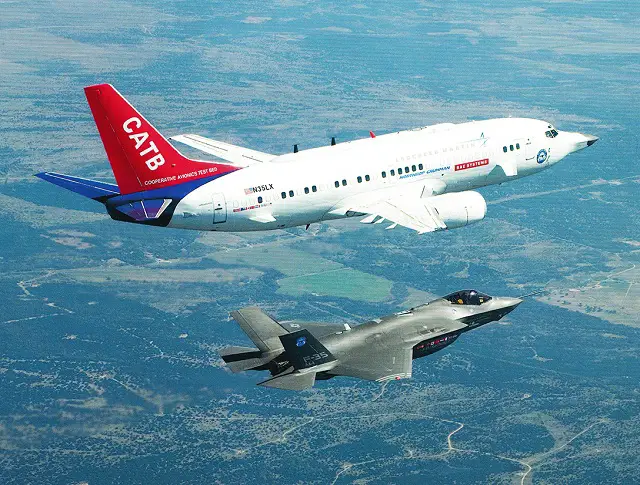Breaking news
"CATBird" 737 Based F-35 Test Bed Performs in JPALS All-Weather Landing System Testing.
| 2015
 Team
members of the F-35 Lightning II Cooperative Avionics Test Bed (CATBird),
a modified Boeing 737-330, take a moment to appreciate the results of
initial connectivity testing between the F-35 and a Joint Precision Approach
and Landing System (JPALS) test facility at Patuxent River, Md. November
2014. (U.S. Navy photo courtesy of Lockheed Martin) Team
members of the F-35 Lightning II Cooperative Avionics Test Bed (CATBird),
a modified Boeing 737-330, take a moment to appreciate the results of
initial connectivity testing between the F-35 and a Joint Precision Approach
and Landing System (JPALS) test facility at Patuxent River, Md. November
2014. (U.S. Navy photo courtesy of Lockheed Martin) |
|||
At present,
CATBird is supporting the development of software scheduled for release
this year. The software is part of the Block 3F software build for upcoming
F-35B/C developmental and operational tests. The F-35 is currently integrating the UHF Data Broadcast (UDB) radio with the JPALS ship system as an interim solution during development of an auto-land capability into the JPALS ship system. This capability will allow the Navy to recover aircraft in all-weather conditions by removing human error from the carrier landing process. To date, UDB tests have been a success due to the collaboration between PMA-213 and industry partners, Taylor noted. |
|||






























 The
F-35 Cooperative Avionics Test Bed (CATBird) supports software development
for upcoming F-35B/C developmental and operational tests, including
the elements of the Joint Precision Approach and Landing System (JPALS).
When fully implemented, JPALS will benefit carrier-based air traffic
control by enabling automatic carrier landings (auto-land), enhancing
aircraft position reporting, and increasing Tactical Air Navigation
(TACAN) functionality. (U.S. Navy photo courtesy of Lockheed Martin)
The
F-35 Cooperative Avionics Test Bed (CATBird) supports software development
for upcoming F-35B/C developmental and operational tests, including
the elements of the Joint Precision Approach and Landing System (JPALS).
When fully implemented, JPALS will benefit carrier-based air traffic
control by enabling automatic carrier landings (auto-land), enhancing
aircraft position reporting, and increasing Tactical Air Navigation
(TACAN) functionality. (U.S. Navy photo courtesy of Lockheed Martin)